about spinning reels
To minimise weight, spinning reels are constructed of a variety of lightweight alloys that make them prone to corrosion by seawater.
Budget reels have the least protection against the ingress of seawater, using nylon sleeves to reduce friction between revolving and moving parts.
To reduce seawater ingress in mid-priced reels, seals are introduced with ball bearings replacing some of the 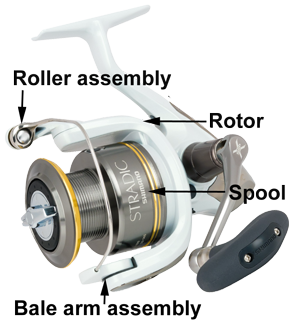 nylon sleeves.
nylon sleeves.
The most expensive reels usually have harder wearing gears with sophisticated seals to further reduce seawater ingress, with bearings on all of the moving parts to reduce friction.
However, to counteract the corrosive effect of seawater in budget spinning reels or to maintain the value of expensive reels, manufacturers recommend rinsing the reel with fresh water after use, paying particular attention to the roller and bale arm assembly's.
To reduce the cost and further reduce water ingress, some manufacturers no longer fit a reverse gear or ship reels with a spare spool.
types of spinning reels
All fixed spool spinning reels have a rotor with a strong wire-like bale arm secured across it, which is pulled back to the open position allowing line to be released from the spool during casting. As soon as the handle is turned to retrieve line the bale arm snaps closed, picking up the line and guiding it into the roller assembly. As the line is retrieved it is wrapped onto the spool with an oscillating action as the spool moves backwards and forwards.
The drag is a manually set mechanism that allows the spool to turn and release line under tension to stop the line breaking.
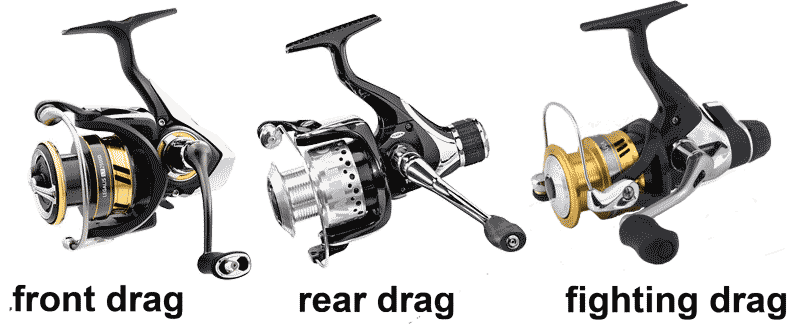 The most popular fixed spool spinning reels by far are those with a drag tension ring on the front of the spool. Unscrewing the drag tension ring allows the spool to be removed.
The most popular fixed spool spinning reels by far are those with a drag tension ring on the front of the spool. Unscrewing the drag tension ring allows the spool to be removed.
Slightly heavier are those with a drag tension-knob on the rear of the body, with a button on the front of the spool allowing it to be easily removed.
The heaviest reels are those with a fighting or fast drag lever situated in front of the rear drag knob. With the fighting drag lever in the upright position, the drag is set as required with the drag tension knob. Turning the fighting drag lever clockwise increases the drag tension, turning it anticlockwise reduces the drag tension.
line capacity
Because the weight of lure is rarely going to exceed 28g, don't expect to cast it more than 60-70m. With this in mind a suitable spinning reel will have a minimum line capacity of around-
Mono line—150metres of 5·5kg (12 lb), 0·28m.
Braid line— 150m of 8·1kg (18 lbs), 0·13mm.
Working with these numbers makes choosing a suitably light reel much easier, particularly as braided line is commonly sold in 150m and 300m spools. 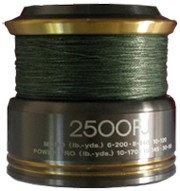
The Shimano Exage 2500FD spool illustrated is marked as—
Mono (lb.-yds.) 6-200. 8-140. 10-120.
Power Pro (lb.-yds.) 10-170. 15-145. 30-95.
making it good to load with 15 lb. (6·8kg.) PE Power Pro braided line.
Again shipping with a spare spool, the skirt of a Diawa Caldia 2500A 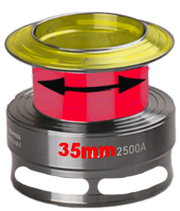 reel is marked—
reel is marked—
lb.(Dia mm) - m(yds). 6lb(0·25)-190(210). 8lb (0·28)-155m(170)
making it good to go with 6·9Kg
0·26mm Dia Quantum Exo line. Alternatively, back the barrel of the spool out to 3.5cm dia. with electrical tape and and load it with 150m of Diawa JBraid x8 (0·13 Dia).
large or small spool
It is argued that the lure will cast further from a larger spool, as the line has fewer revolutions when being dispensed from the spool. Others however believe the additional weight of a larger reel is not worth it considering most of the friction is caused by the line passing through the line guides, which is constant, negating any advantage that might be gained using a larger spool.
closed face, spincast and bait caster reels

Closed Face, Spincast and Baitcaster multiplying reels are designed for the huge USA market—most having a right hand retrieve. The Closed Face Spincast reels have a button on the back that is pressed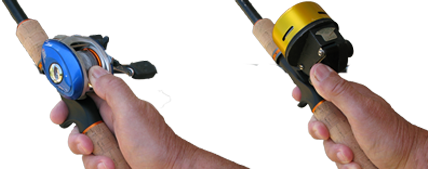 down to hold the line and released to free line for casting. The bale pin immediately picks up the line as soon as the handle is turned to retrieve line. All have adjustable drag mechanisms and are designed to be used with trigger grip casting rods.
down to hold the line and released to free line for casting. The bale pin immediately picks up the line as soon as the handle is turned to retrieve line. All have adjustable drag mechanisms and are designed to be used with trigger grip casting rods.
A baitcaster reel is the same as any other multiplying reel with at least two sophisticated braking systems to stop over-runs. As with any level wind multiplying reel, before casting position the eye of the level wind opposite the middle of the spool.
Until the late 1970's the full range of Abu Svängsta closed face reels and Diawa spincast range, were available in the Europe. But never being popular, to arouse more interest Diawa launched the Underspin XD range and ABU the 506 range. Both hang beneath the rod in the style of a fixed spool reel and have a left hand only wind. For 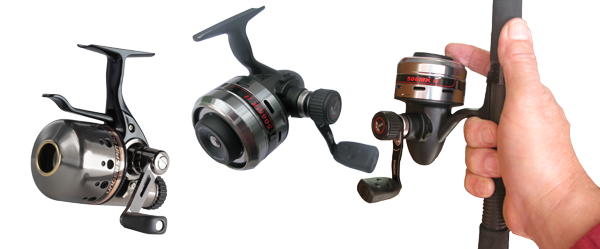 casting, the Diawa has a simple trigger release whilst the ABU has a line release button at the front of the reel. To cast the Abu reel, the line release button is pressed and the line flicks to the finger. On both makes the bale pin picks up the line as soon as the retrieve begins. The drag adjuster is on the end of the Diawa reel whilst the Abu Syncro drag is on the handle assembly. Both makes are designed to be loaded 10 lb (4.5kg) or lighter line.
casting, the Diawa has a simple trigger release whilst the ABU has a line release button at the front of the reel. To cast the Abu reel, the line release button is pressed and the line flicks to the finger. On both makes the bale pin picks up the line as soon as the retrieve begins. The drag adjuster is on the end of the Diawa reel whilst the Abu Syncro drag is on the handle assembly. Both makes are designed to be loaded 10 lb (4.5kg) or lighter line.


